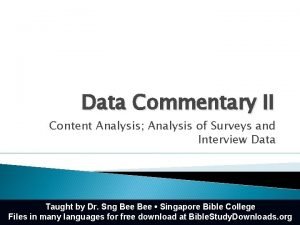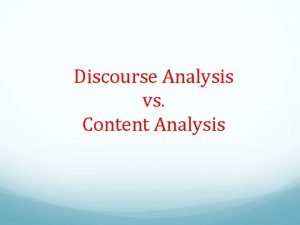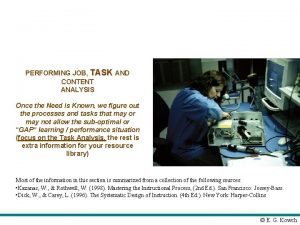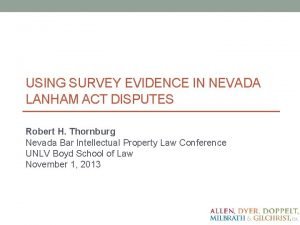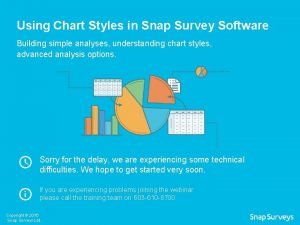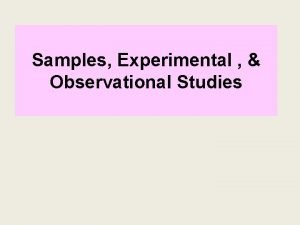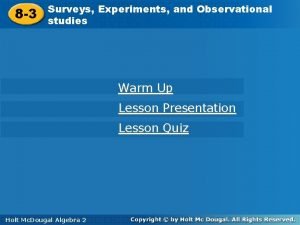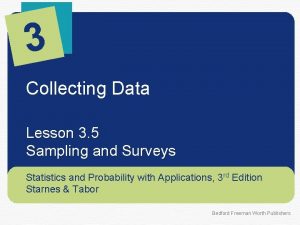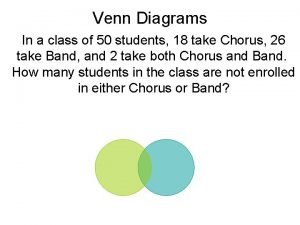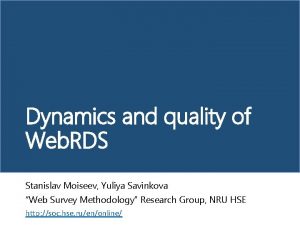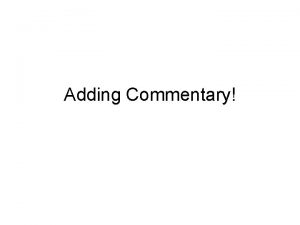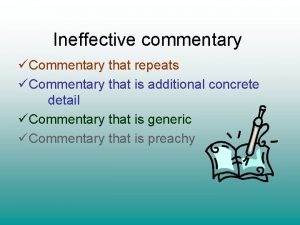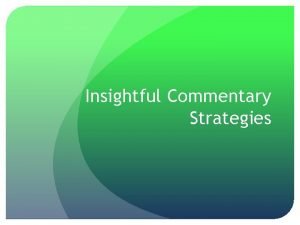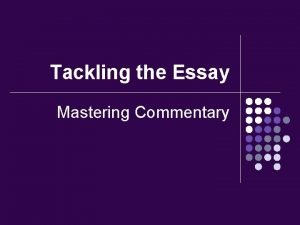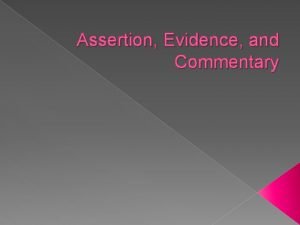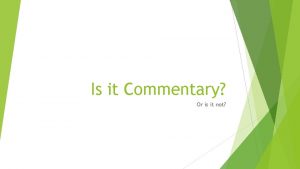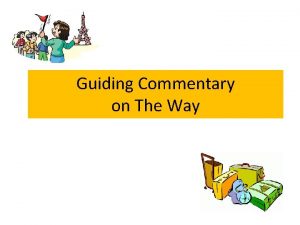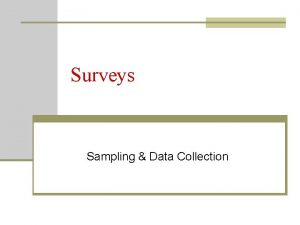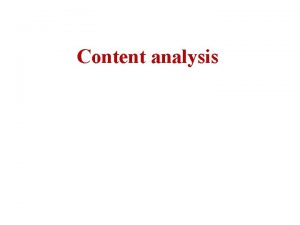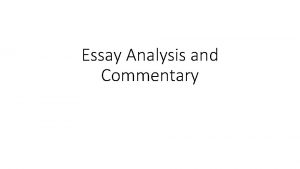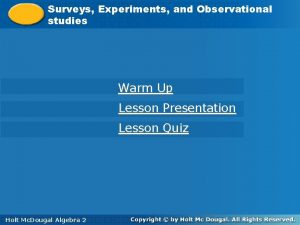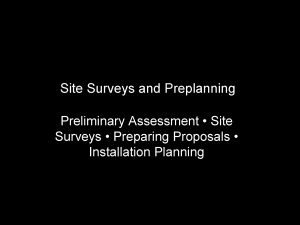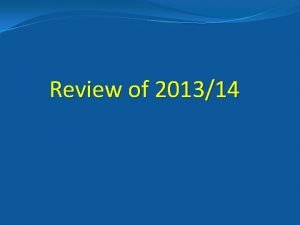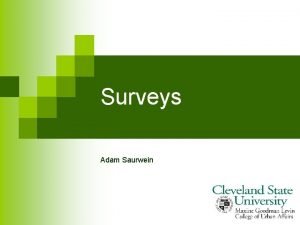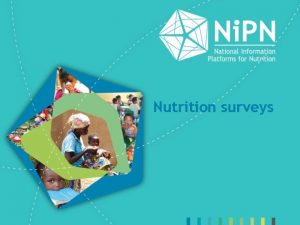Data Commentary II Content Analysis Analysis of Surveys






























- Slides: 30

Data Commentary II Content Analysis; Analysis of Surveys and Interview Data Taught by Dr. Sng Bee • Singapore Bible College Files in many languages for free download at Bible. Study. Downloads. org

Why use interviews? Gray, David E. , Doing Research in the Real World. (2 nd ed. ). London: Sage, 2009. � Interviewing is a powerful way of helping people to make explicit things that are hitherto been implicit – to articulate their tacit perceptions, feelings and understandings. (Arksey and Knight, 1999: 32)

Content Analysis-Analyze the following advertisement entitled ‘Unveiling the Truth’

Content Analysis Rosenwasser, David and Stephen, Jill (2009), Writing Analytically, Sixth Edition. Canada: Thomson Wadsworth. Data Method of Analysis Interpretiv e Leaps Subject in the advertisement is glaring at the reader Make the implicit explicit The man in the advertisement is confronting and challenging the readers Locate pattern of same detail; make what is implicit in pattern of details explicit. Locate organizing contrast; make what is implicit in the contrast explicit. Anomalies; make what is implicit in the anomalies explicit.

Content Analysis Data Method of Analysis Interpretiv e Leaps Subject in the advertisement is glaring at the reader Make the implicit explicit The man in the advertisement is confronting and challenging the readers The man depicted in the mask looks clean cut. He has neat and short hair. Locate pattern of same The advertisement suggests detail; make what is implicit that the mask the man puts in pattern of details explicit. on is a self that is neat cut, harmless and conformist. The man underneath the mask looks aggressive. His eyes glare right at the reader and his mouth is open, suggesting anger. Locate organizing contrast; make what is implicit in the contrast explicit. This suggests that beneath the clean cut look, the man is aggressive and angry. The aggressive man beneath the first mask is wearing another mask that hides his real features. Anomalies; make what is implicit in the anomalies explicit. This suggests that the man wears more than one layer of mask. He is hiding his real self beneath many layers of mask.

Types of Interviews Gray, David E. , Doing Research in the Real World. (2 nd ed. ). London: Sage, 2009. �Structured interviews �Semi-structured interviews �Non-directive interviews �Focused interviews �Informal conversational interviews

Analyse an interview Gray, David E. , Doing Research in the Real World. (2 nd ed. ). London: Sage, 2009. �Watch a video of an interview �From the content of the interview, look for evidence of interviewer bias in the questions, the way they are expressed, or the non-verbal behaviour of the interviewer.

Tips on Conducting Interviews Gray, David E. , Doing Research in the Real World. (2 nd ed. ). London: Sage, 2009. � Before conducting the interview, get the interviewees to be as relaxed as possible; � Know what the interview is seeking to find out; � Ask the right questions � Give appropriate verbal and non-verbal feedback � Vary the question order to fit the flow of the interview � Vary the phrasing of the questions to help the conversation seem natural

Analysis of data Rosenwasser, David and Stephen, Jill (2009), Writing Analytically, Sixth Edition. Canada: Thomson Wadsworth. � Describe with care. The words you choose to summarize your data will contain your key ideas � In moving from summary to ideas, think carefully about the language you have chosen.

Points to be Wary About in Analysis Rosenwasser, David and Stephen, Jill (2009), Writing Analytically, Sixth Edition. Canada: Thomson Wadsworth. � Take note of the following rules: 1. Make associations of the detail or words in the context of the advertisement/text. 2. Take care not to make the interpretive leap stretch further than what the actual details support. 3. We tend to transfer meanings from our own life into the subject. You need to ask yourself what other explanations may account for the detail and compare your interpretation with members in your group.

Exercise: Analyze the poverty trend in the following graph

The regional picture is one of highly uneven progress 1. The new international poverty line set at $1. 25 a day in 2005 prices instead of a dollar a day in 1993 prices. The international poverty line was set to measure poverty in the world by the standards of what poverty means in low-income countries, so the data that goes into the analysis is the poverty lines that are actually used in poor countries. 2. A major effort has been made to update and improve data on the world’s poor, including both new data on the cost-of-living in developing countries and new household surveys. 3. As in past estimates, the composition of world poverty has changed noticeably over time. Numbers of poor have fallen in Asia, but risen elsewhere as shown in Figure 1 4. As can be seen in Figure 1, there is a dramatic progress in East Asia. Looking back to the early 1980 s, East Asia was the region with the highest incidence of poverty in the world, with almost 80% living below $1. 25 a day in 1981. By 2005 this had fallen to 18%.

The regional picture is one of highly uneven progress 5. There are 600 million fewer people living in poverty by this standard in China alone, though progress in China has been uneven over time. 6. In the developing world outside China, the $1. 25 poverty rate has fallen from 40% to 29% over 1981 -2005, though not enough to bring down the total number of poor, which has stayed at around 1. 2 billion. 7. The poverty rate has fallen in South Asia from 60% to 40% between 1981 and 2005. But this has not been enough to bring down the number of poor. 5. Rising incidence and number of poor in Eastern Europe and Central Asia, though with signs of progress since the late 1990 s.

Comments on Figure 1 9. Of course, data are never ideal, but they are getting better over time As a consequence of the improvements in price data collection and processing, it is discovered that the cost of living is higher in the developing world than expected. So past estimates of the level of poverty in the developing world have to be revised upwards in the light of these new data. 10. The new data indicate a higher count of the number of poor The old data suggested that the poverty count had fallen below one billion, but with the upward adjustment to the cost -of-living in developing countries we estimate that 1. 4 billion people in the world are still poor by the standards of the poorest countries. 2. 6 billion people consume less than $2 a day in 2005 prices.

Questions on the Data Commentary 1. 2. 3. 4. What are the purposes of sentences 1 and 2. What are the features of this text that make it an example of written academic English? Which sentence contains the author’s key point? In Slide 1, the purposes for data commentaries are listed. In which category does each sentence fall into.

Structure of Data Commentary � 1. 2. 3. Data commentaries often have the following elements in the following order: Location, elements and/or summary statements Highlighting elements Discussions of implications, problems, exceptions, recommendations etc.

Location + indicative summary 1. As in past estimates, the composition of world poverty has changed noticeably over time. Numbers of poor have fallen in Asia, but risen elsewhere as shown in Figure 1. The new international poverty line is set at $1. 25 a day in 2005 prices instead of a dollar a day in 1993 prices. The international poverty line was set to measure poverty in the world by the standards of what poverty means in lowincome countries, so the data that goes into the analysis is the poverty lines that are actually used in poor countries. A major effort has been made to update and improve data on the world’s poor, including both new data on the cost-of-living in developing countries and new household surveys. As can be seen in Figure 1, there is a dramatic progress in East Asia. Looking back to the early 1980 s, East Asia was the region with the highest incidence of poverty in the world, with almost 80% living below $1. 25 a day in 1981. By 2005 this had fallen to 18%. Linking ‘as’ clause and highlight Implications

Location Elements and Summary Data commentary often begins with location elements and summary. Location Elements: ü Refer readers to the table, chart or graph ü They are a form of metadiscourse – reveal organization, parts of text and logical connections

Starting a Data Commentary Location Element Summary a. Table 5 shows b. Table 2 provides there is a dramatic progress in East Asia. c. Figure 2 plots the poverty rate in South Asia which has fallen from 60% to 40% between 1981 and 2005. d. Figure 4 gives the poverty rate which has fallen in South Asia from 60% to 40% between 1981 and 2005. that the composition of world poverty has changed overtime.

Passives in Starting a Data Commentary Summary a. Location Element The composition of world poverty has changed overtime are shown in Table 5. b. There is a dramatic progress in East Asia are provided in Table 5. c. The poverty rate in South Asia which has fallen from 60% to 40% between 1981 and 2005 are plotted in Figure 2. d. The poverty rate which has fallen in South Asia from 60% to 40% between 1981 and 2005 are given in Figure 4.

Verbs Indicative and Informative Verbs Active Verbs following References to Visuals Passive Verbs in Reference to Visuals Show Provide Give Present Summarize Illustrate Reveal Display Demonstrate Indicate Suggest Shows Presents Illustrates Summarizes Demonstrates Contains Provides Depicts Lists Reports Shown in Illustrated in Presented in Given in Listed in Seen in Provided in Summarized in Seen from

Interpreting Interview Data – What is Interpretation Rosenwasser, David and Stephen, Jill (2009), Writing Analytically, Sixth Edition. Canada: Thomson Wadsworth. �Meaning is contextual, meaning it always occurs inside some social, cultural or other frame of reference

Pushing Observations to Conclusions: Asking So What? Question. Rosenwasser, David and Stephen, Jill (2009), Writing Analytically, Sixth Edition. Canada: Thomson Wadsworth. �What does the data imply? �Why does this data matter? �Where does this observation get us? �How can we begin to generalize about the subject?

Pushing Observations to Conclusions: Asking So What? Question. Rosenwasser, David and Stephen, Jill (2009), Writing Analytically, Sixth Edition. Canada: Thomson Wadsworth. Ask the so what? question Observations Ask the so what? question Implications Conclusions

Make an Outline � Look at your results and see how they can be grouped or organized logically. � Name the groups of categories � Make an outline for your results section � Use appropriate headings and subheadings

1) Your Research Objective � Your research objective is a central theme that runs throughout your research report � You can use parts of your research objective as headings � Another way you can construct your headings is the operationalization of your key concept, e. g. on the research topic of ‘importance of outward appearance’, you can have the heading ‘work’, ‘relationships’ and ‘people’s perception’.

2) The difference between reporting results and interpreting results �Reporting results is to explain what your found e. g totals, averages and percentages �Interpreting the results is to answer the ‘so what? ’ question, in other words, the implications of the results, suggesting improvements and solutions.

3) Plotting Graphs � Design graphs to include in your Results Section that reveal significant findings in your study. � Choose two related variables and plot them in the x and y axis of your graphs. � Analyze the variables in the handout and answer the questions


Get this presentation for free! Research & Writing link at Bible. Study. Downloads. org
 Secondary content analysis
Secondary content analysis Real content and carrier content in esp
Real content and carrier content in esp Static content vs dynamic content
Static content vs dynamic content Data commentary sample
Data commentary sample Data commentary example
Data commentary example Data commentary example
Data commentary example Claim data commentary example
Claim data commentary example Difference between content analysis and discourse analysis
Difference between content analysis and discourse analysis Content analysis and task analysis
Content analysis and task analysis Lanham act survey
Lanham act survey Snap survey software
Snap survey software Real eyes surveys
Real eyes surveys Biased and unbiased samples
Biased and unbiased samples Rebuttal surveys
Rebuttal surveys Physical security surveys
Physical security surveys What is literature
What is literature Surveys.panoramaed/everett
Surveys.panoramaed/everett Highway surveys
Highway surveys Partial discharge survey
Partial discharge survey Survey experiment or observational study
Survey experiment or observational study Lesson 3.5 what is wrong with these surveys
Lesson 3.5 what is wrong with these surveys Syndicated data companies
Syndicated data companies Survey.panoramaed.com/ecisd
Survey.panoramaed.com/ecisd A veterinarian surveys 26 of his patrons
A veterinarian surveys 26 of his patrons Togus pond maine water quality
Togus pond maine water quality Double barreled question
Double barreled question Surveys.pano
Surveys.pano Webrds
Webrds Surveys of enacted curriculum
Surveys of enacted curriculum üinterest
üinterest Internal client satisfaction survey
Internal client satisfaction survey



